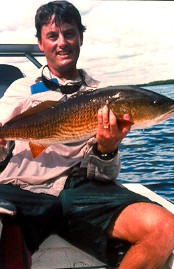

 EDUCATION
EDUCATION
Aaron recieved a Bachelor of Arts degree in Biology from St. Mary's College of Marlyland in 1987. He continued his education at the College of William and Mary,
Virginia Institute of Marine Science, where he recieved a Masters degree in Marine Science in 1993. Aaron went on to recieve a Ph.D. in Environmental Biology at the University
of Massachusettes Boston in 2001. He has been with Mote since October 2001.
 BIOLOGY INTERESTS
BIOLOGY INTERESTS
My interest is in conducting research that can be directly applied to
marine conservation, and by doing so effectively contribute to
conservation and management policy formulation. Successful conservation
science necessitates collaborating with academic, government, and
private sectors to ensure that quality research of an applied nature is
conducted, with a primary goal of contributing directly to conservation
policy. As marine conservation biology matures as a science, scientists
must provide scientifically rigorous research that (a) contributes to
our basic understanding of marine systems, (b) furnishes management and
conservation agencies with the information they need to resolve
immediate issues, and (c) incorporates policy considerations so that
research findings are applicable.
My primary research interest is to examine the connection between nursery
and adult habitats for species that undergo ontogenetic habitat shifts.
While many studies have examined the spatial and temporal components
of settlement or juvenile abundance, fewer have addressed the connection
between settlement and adult abundance. Current research addresses the
connection between settlement and post-settlement abundance, nursery
habitat use, and adult abundance for species that undergo ontogenetic
habitat shifts. Species of particular concern in Charlotte Harbor are
Centropomus undecimalis, Sciaenops ocellatus, and Cynoscion nebulosus.
A second research goal is to incorporate a comparative approach into
research that examines use of multiple habitats and anthropogenic
impacts. The southeastern United States is particularly intriguing for
this work because the coastal environment is such a mosaic - with
habitats ranging from highly impacted to isolated and almost pristine -
that comparative studies will be exceptionally valuable. Moreover,
since the species of interest use numerous habitats throughout their
life histories, they provide a challenging focus for research.
Finally, long-term data are important for developing base-lines on
temporal scales that are appropriate for marine conservation. For
example, considering the annual variation in settlement of fish larvae,
settling individuals of a species may utilize habitats differently under
different densities. Long-term monitoring incorporated into a research
plan addresses factors effecting fishes over a long enough period to
examine the impact of high or low juvenile abundance on adult
populations, and provides data relevant to determining the relative
importance of both natural and anthropogenic disturbances.
 SOME PUBLICATIONS
SOME PUBLICATIONS
Adams, A.J. 1999. Characteristics of fish assemblages associated with
artificial reefs and adjacent natural reefs. Proceedings of the 47th Annual
Gulf and Carribean Fisheries Institute.
Adams, A.J. 2001. Effects of a hurricane on two assemblages of coral reef
fishes: multiple-year analysis reverses a false 'snapshot' interpretation.
Bull. Mar. Sci. 69(2): 341-356.
Adams, A.J. and J.P. Ebersole. 2002. Use of lagoon habitats and back-
reef by coral reef fishes. Mar. Ecol. Prog. Ser. 228:213-226
Adams, A.J. and J.P. Ebersole. In Press. Processes affecting recruitment
inferred from distributions of coral reef fishes. Bull. Mar. Sci.
Adams, A.J. and J.P. Ebersole. In Review. Resistance of coral reef fishes of
back-reef and lagoon habitats to a hurricane. Bull. Mar. Sci.
Adams, A.J., J.V. Locascio, B.D. Robbins. In Press. Microhabitat use by
a post-settlement stage estuarine fish: evidence from relative abundance
and predation among habitats. J. Exp. Mar. Biol. Ecol.
Adams, A.J., R.J. Miller, and J.P. Ebersole. In Press. Tethers make
juvenile surgeonfishes (Acanthuridae) vulnerable to attacks by benthic
invertebrates. Bull. Mar. Sci.
Adams, A.J. and W.J. Tobias. 1999. Mangroves as nursery grounds for
recreational fisheries. Proceedings of the 46th Annual Gulf and
Caribbean Fisheries Institute.
Miller, R.J., A.J. Adams, N.B Ogden, J.C. Ogden, and J.P. Ebersole. 2003. Diadema
antillarum 17 years after mass mortality. Coral Reefs. 22:181-187.


This Page Created By: Maggie Newton - E-mail me!
Last Updated on: February 19, 2004